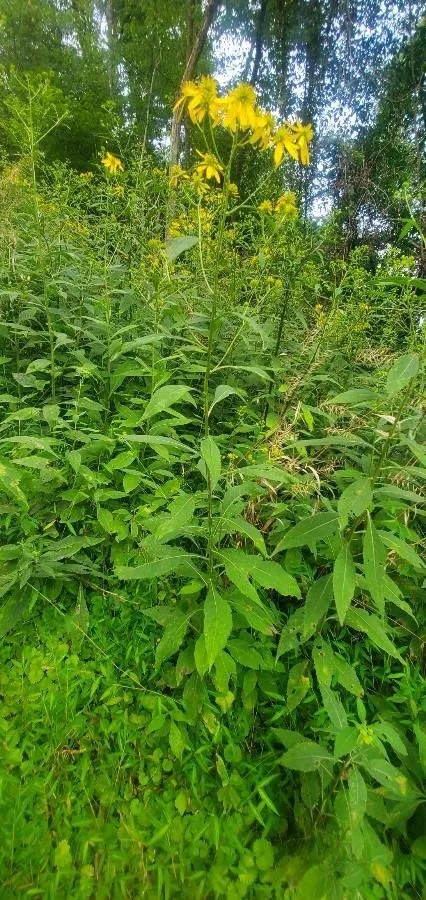
Author: (L.) Britton ex Kearney
Bibliography: Bull. Torrey Bot. Club 20: 485 (1893)
Year: 1893
Status: accepted
Rank: species
Genus: Verbesina
Vegetable: False
Observations: SE. Canada to U.S.A.
Wingstem: A Radiant Wildflower of North America
The Wingstem, scientifically known as Verbesina alternifolia, is a notable member of the Asteraceae family. This remarkable plant is distinguished by its vivid, yellow flowers and tall, winged stems, which contribute to its common name. Verbesina alternifolia thrives in the diverse environments ranging from the southeastern regions of Canada to various parts of the United States.
The Wingstem is revered for its robust structure and its adaptability to different ecological settings. This hardy perennial can often be found in moist, rich soils, commonly flourishing in meadows, along riverbanks, and in woodlands where it can reach impressive heights, typically standing between 4 to 8 feet tall.
One of the most striking features of the Wingstem is its leaves, which are alternately arranged along the stem, contributing to the plant’s scientific name, alternifolia. The stem itself features distinctive, wing-like extensions that run along its length, creating a unique and easily recognizable silhouette.
Flowering from late summer into early fall, Verbesina alternifolia attracts a plethora of pollinators, including bees and butterflies, making it an essential component of many natural ecosystems. The radiant yellow blooms not only add a splash of color to the landscape but also play a crucial role in supporting local biodiversity.
Documented in “Bulletin of the Torrey Botanical Club” in 1893, the plant has sustained its botanical significance over the years. Annotated by the renowned botanists (L.) Britton and Kearney, the Wingstem continues to be a subject of admiration and study among plant enthusiasts and ecologists alike.
Growing a Wingstem can be a delightful addition to naturalistic gardens, offering both ecological benefits and aesthetic appeal. Its ability to thrive in less-than-ideal soil conditions makes it a practical choice for gardeners seeking low-maintenance yet striking flora.
Overall, the Wingstem, with its captivating appearance and important role in supporting pollinator populations, remains a cherished species within the Asteraceae family, demonstrating nature’s resilience and beauty through its vibrant presence across North America.
Eng: wingstem, alternate-leaved crownbeard
Nld: verbesina
Fra: verbésine à feuilles alternes, éclipte
En: Wingstem, Alternate-leaved crownbeard
Nl: Verbesina
Fr: Verbésine à feuilles alternes, Éclipte
Taken Sep 3, 2022 by Anna P (cc-by-sa)
Taken Sep 6, 2021 by Dango Dango (cc-by-sa)
Taken Aug 18, 2022 by John Reynolds (cc-by-sa)
Taken Sep 5, 2022 by James James Fishwick (cc-by-sa)
Taken Aug 30, 2020 by Christoan Chouvenc (cc-by-sa)
Taken Dec 14, 2021 by Monteiro Henrique (cc-by-sa)
Taken Aug 18, 2021 by Mike (cc-by-sa)
Taken Aug 16, 2022 by Diana Sedgwick (cc-by-sa)
Taken Aug 30, 2020 by Cynthia Perdue (cc-by-sa)
Taken Jul 18, 2022 by Isaac Hicks (cc-by-sa)
Taken Aug 20, 2015 by EOL − Jenny Smith (cc-by-nc)
Taken Aug 20, 2015 by EOL − Jenny Smith (cc-by-nc)
Taken Sep 17, 2015 by EOL − leptodia (cc-by-nc)
Taken Oct 11, 2003 by EOL − Steven J. Baskauf (cc-by-nc-sa)
Taken Aug 30, 2020 by Cynthia Perdue (cc-by-sa)
Taken Sep 7, 2022 by skoog erin (cc-by-sa)
Taken Jan 1, 1900 by EOL − WVU Herbarium (cc-by-nc-sa)
Taken Oct 11, 2003 by EOL − Steven J. Baskauf (cc-by-nc-sa)
Taken Oct 11, 2003 by EOL − Steven J. Baskauf (cc-by-nc-sa)
Taken Sep 2, 2022 by Luceau Anthony (cc-by-sa)
Taken Aug 17, 2015 by EOL − leptodia (cc-by-nc)
Taken Aug 17, 2014 by EOL − Evan Raskin (cc-by-nc)
Taken Oct 11, 2003 by EOL − Steven J. Baskauf (cc-by-nc-sa)
Taken Aug 27, 2015 by EOL − botany08 (cc-by)
Taken Aug 16, 2022 by Diana Sedgwick (cc-by-sa)
Taken Jul 15, 2009 by Photoflora – Benoit BOCK (©)
Taken Jul 15, 2009 by Photoflora – Benoit BOCK (©)
Taken Jul 15, 2009 by Photoflora – Benoit BOCK (©)
Family: Myrtaceae Author: (F.Muell.) K.D.Hill & L.A.S.Johnson Bibliography: Telopea 6: 402 (1995) Year: 1995 Status:…
Family: Rubiaceae Author: Pierre ex A.Froehner Bibliography: Notizbl. Bot. Gart. Berlin-Dahlem 1: 237 (1897) Year:…
Family: Sapindaceae Author: Koidz. Bibliography: J. Coll. Sci. Imp. Univ. Tokyo 32(1): 38 (1911) Year:…
Family: Asteraceae Author: A.Gray Bibliography: Pacif. Railr. Rep.: 107 (1857) Year: 1857 Status: accepted Rank:…
Family: Fabaceae Author: Medik. Bibliography: Vorles. Churpfälz. Phys.-Ökon. Ges. 2: 398 (1787) Year: 1787 Status:…
Family: Aspleniaceae Author: (Cav.) Alston Bibliography: Bull. Misc. Inform. Kew 1932: 309 (1932) Year: 1932…